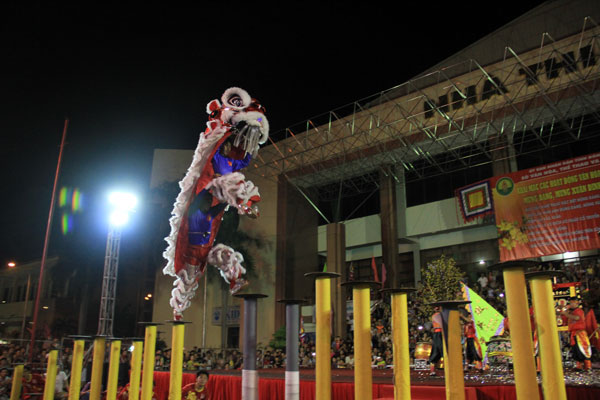
The three main regions of Vietnam are characterised by different climate and soil conditions that result in different traditions and customs, and some of these have to do with which traditional dishes are favoured and how they are prepared when Tet, the Lunar New Year, is celebrated.
The three main regions of Vietnam are characterised by different climate and soil conditions that result in different traditions and customs, and some of these have to do with which traditional dishes are favoured and how they are prepared when Tet, the Lunar New Year, is celebrated.
Taking as example the banh chung and banh tet, which are the most important Tet dishes. While people in the north prefer banh chung – square cake, residents in the former royal capital city of Hue in the central region prefer banh tet – the cylinder sticky rice cake that is said to symbolise a shoulder pole (the Centre) carrying two baskets (the North and the South) at either ends.
Taking as example the banh chung and banh tet, which are the most important Tet dishes. While people in the north prefer banh chung – square cake, residents in the former royal capital city of Hue in the central region prefer banh tet – the cylinder sticky rice cake that is said to symbolise a shoulder pole (the Centre) carrying two baskets (the North and the South) at either ends.
 |
| Food offerings to ancestors in Hue on Lunar New Year's Day (Photo: Internet) |
Another difference that can be seen is that the sizes of the cakes are smaller in the central region. Hue residents like to claim that this denotes an emphasis for sophistication rather than volume, as also greater skills required to shape and wrap the smaller cakes.
While banh chung and banh tet are the items that Hue inherited from ancestors who came in from the North, dua mon, which is sliced papaya, kohlrabi, carrot and onion preserved in salt, sugar and vinegar, is a ‘endemic’ Tet dish of locals. It is as an accompaniment to banh chung and banh tet in order to enjoy a combination of different tastes - sweet, salty, fatty and spicy.
Predicting the Tet weather in Hue is a difficult task. It might be hot at above 30 Celsius degrees or be cold under 15 Celsius degrees with continuous rains for a week. With such unpredictable weather conditions, banh tet and dua mon are the best choices for Tet food, since they can be preserved for up to 15 days, and people do not have to spend too much time in the kitchen.
Most Vietnamese men drink alcohol to celebrate Tet. And as a tradition, Hue women also prepare food for the drinkers, like slices of pig stomach and Roxburgh fig (Ficus auriculata) soaked in sweetened fish sauce. This fig preparation is a Hue specialty because the tree does not grow so well outside Thua Thien- Hue province.
Blessed with a lot of sunlight and rich soil to grow plants and vegetables all year round, the southern region enjoys an abundance of fruits, vegetables and seafood. So there is an air of unmistakable prosperity here, compared to other rural regions in the country.
Their Tet food, apart from the banh chung and banh tet, are easy to cook, with some of the more popular dishes including pork cooked in coconut milk and a soup cooked with bitter gourd stuffed with mushrooms and pork.
Coconut palms can be found everywhere in the South, and bitter gourds grow in just about every garden. The fruit is called kho qua in the south. Literally, kho means hardships in life and qua means over. The kho qua soup conveys the wish to overcome hardships in the coming year.
These dishes are easy to cook, taking very little time compared to the week-long preparations that Hue dishes involve.
Most Vietnamese men drink alcohol to celebrate Tet. And as a tradition, Hue women also prepare food for the drinkers, like slices of pig stomach and Roxburgh fig (Ficus auriculata) soaked in sweetened fish sauce. This fig preparation is a Hue specialty because the tree does not grow so well outside Thua Thien- Hue province.
Blessed with a lot of sunlight and rich soil to grow plants and vegetables all year round, the southern region enjoys an abundance of fruits, vegetables and seafood. So there is an air of unmistakable prosperity here, compared to other rural regions in the country.
Their Tet food, apart from the banh chung and banh tet, are easy to cook, with some of the more popular dishes including pork cooked in coconut milk and a soup cooked with bitter gourd stuffed with mushrooms and pork.
Coconut palms can be found everywhere in the South, and bitter gourds grow in just about every garden. The fruit is called kho qua in the south. Literally, kho means hardships in life and qua means over. The kho qua soup conveys the wish to overcome hardships in the coming year.
These dishes are easy to cook, taking very little time compared to the week-long preparations that Hue dishes involve.
(Source:VNA)





![[Photo series] Making a living on hills of melaleuca cuttings](/file/e7837c02876411cd0187645a2551379f/122025/tai_xuong_1_20251212220851.jpeg?width=500&height=-&type=resize)